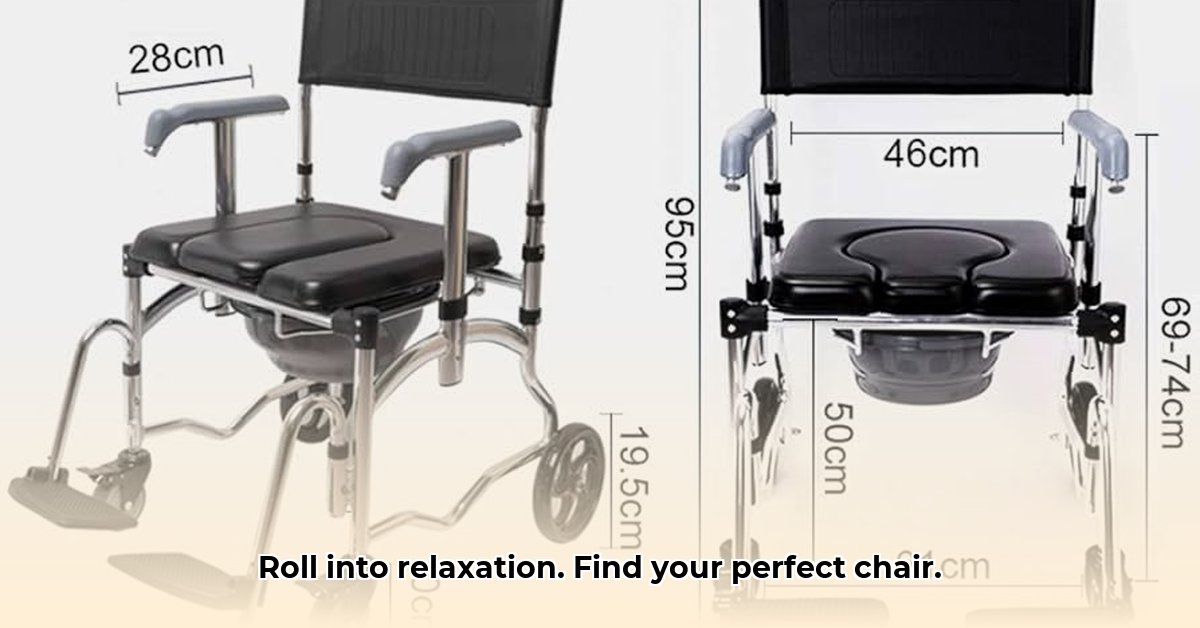Taking a shower should be a comfortable and safe experience, not a struggle. For individuals facing mobility challenges, the right rolling shower chair can restore independence and transform a potentially risky task into a comfortable routine. This comprehensive guide is designed to help you navigate the options, explore essential features, compare different models, understand the various types available, and provide maintenance tips to keep your chair in top condition. We aim to empower you to find the perfect fit for your unique needs, ensuring bath time is worry-free, dignified, and enjoyable.
Rolling Shower Chairs: Your Guide to Safe and Independent Bathing
If mobility is a concern, choosing the appropriate rolling shower chair can make all the difference, turning a potentially risky task into a comfortable and safe routine. This article helps you navigate the choices and find the product that best suits your needs. A carefully selected shower chair can enhance both physical safety and emotional well-being. Let’s make bath time worry-free again with the perfect shower chair that boosts confidence and promotes independence.
Understanding Your Individual Needs: Finding the Right Match
Before diving into specific models, let’s talk about your specific needs. What would make your shower experience ideal? Your weight and height are crucial factors – the chair must comfortably and safely support you without feeling cramped or unstable. Consider any existing medical conditions, such as arthritis or back pain, which may influence the type of seat and back support you require. Can you easily propel yourself, or will you need assistance? If you experience dizziness or balance issues, a chair with a tilt feature might be a great option, providing extra stability and preventing falls. Think about your bathroom layout – do you have ample space for maneuvering, or are you working with a tighter area? Do you require a chair with a built-in commode for added convenience, eliminating the need for separate transfers to the toilet? Do you need a chair that can roll over an existing toilet? Answering these questions will help narrow your search for the best shower chair to meet your needs. For instance, someone needing more support might prefer a chair with wider, more stable wheels and padded armrests for leverage. Consider also whether you need a chair that is easily portable for travel.
Types of Rolling Shower Chairs
There are several different types of rolling shower chairs, each designed to address specific needs and preferences:
-
Standard Rolling Shower Chairs: These basic models typically feature a simple seat, backrest, and four wheels with locking mechanisms. They are suitable for individuals who need minimal support and can transfer independently.
-
Rolling Shower Commode Chairs: These chairs combine the functions of a shower chair and a commode, featuring an open seat design and a removable commode bucket. They are ideal for individuals who have difficulty transferring to a separate toilet.
-
Tilt-in-Space Rolling Shower Chairs: These chairs allow the user to be tilted backward, relieving pressure on the hips and lower back. They are beneficial for individuals with limited mobility, pressure sores, or a high risk of falls.
-
Reclining Rolling Shower Chairs: Similar to tilt-in-space chairs, reclining models allow the user to recline to a more horizontal position. This can be helpful for individuals with respiratory issues or who need to lie down during showering.
-
Bariatric Rolling Shower Chairs: These heavy-duty chairs are designed to accommodate individuals with larger body sizes. They typically have a higher weight capacity and a wider seat.
Key Features and Specifications: A Side-by-Side Comparison
To help you compare, here’s a table highlighting key features of several popular rolling shower chair models. Remember, prices can vary significantly depending on the retailer and any ongoing sales, so always confirm current pricing.
| Model | Weight Capacity (lbs) | Dimensions (LxWxH, in) | Wheel Size (in) | Tilt Feature | Commode | Adjustable Height | Material | Price Range |
|---|---|---|---|---|---|---|---|---|
| Shower Chair Model A (Example) | 300 | 24x18x36 | 6 | Yes | Yes | Yes | Aluminum & Plastic | $$$ |
| Shower Chair Model B (Example) | 250 | 22x16x34 | 5 | No | No | Yes | Stainless Steel | $$ |
| Shower Chair Model C (Example) | 350 | 26x20x38 | 8 | Yes | Yes | No | PVC | $$$$ |
| Shower Chair Model D (Example) | 275 | 23x17x35 | 7 | No | No | Yes | Aluminum & Fabric | $$ |
Note: Price ranges are estimates and can change. Always verify dimensions to ensure compatibility with your bathroom space.
How to Choose the Right Rolling Shower Chair: A Simple Step-by-Step Guide
Choosing the right chair is a process, but breaking it down makes it manageable. Follow these steps to find the best rolling shower chair for your situation:
- Assess Your Mobility: Honestly evaluate your current mobility level. Do you need a self-propelling chair, or will you need assistance? Consider your upper body strength as well, especially if you plan to self-propel.
- Measure Your Bathroom: Grab a tape measure and take accurate measurements of your shower and bathroom. Ensure there’s enough space to maneuver the chair comfortably, accounting for door widths, shower entryways, and any obstacles. Pay special attention to the height of your toilet if you intend to use the chair as a commode.
- Determine Weight Capacity: Choose a chair that comfortably supports your weight, ideally exceeding it by a safe margin (at least 25-50 lbs), to prioritize safety and accommodate potential fluctuations in weight.
- Select Essential Features: Do you need a tilt feature for added safety and comfort? What about a commode feature for convenience? Adjustable height? Swing-away armrests for easy transfers? Consider what features would enhance your shower experience and support your independence. Look for chairs with features such as padded seats and backrests for enhanced user comfort.
- Check Out Reviews: Consumer reviews provide valuable insights. Read several reviews from a variety of sources to get a feel for the chair’s strengths and weaknesses. Pay attention to comments about durability, ease of use, and customer service.
- Consult a Professional: An occupational therapist or physical therapist can offer personalized recommendations, tailored to your specific needs and abilities. They can help you find a chair that perfectly suits your individual situation and provide training on safe transfer techniques.
- Consider the Material: Chrome-plated steel is more durable than aluminum or plastic when it comes to wheelchair frames. Steel is a good choice if the chair will be used often, while lightweight chairs are easier to transport.
Safety First: Important Safety Features and Usage Tips
Safety should always be your top priority when selecting and using a rolling shower chair. Look for models with reliable locking wheels (on all four casters), sturdy brakes, and a weight capacity that exceeds your weight. Before each use, always test the brakes to ensure they function correctly. Never exceed the chair’s weight limit. Read the manufacturer’s instructions carefully and follow them diligently. Ensure proper assembly before use.
- Wheel Locks: Engage wheel locks during transfers and while showering to prevent accidental movement.
- Anti-Slip Surfaces: Look for chairs with textured seats or non-slip materials to prevent sliding.
- Proper Posture: Maintain good posture while seated in the chair to prevent back pain and discomfort.
Maintenance and Care: Keeping Your Chair in Tip-Top Shape
Proper maintenance extends the life of your rolling shower chair and ensures safe operation. After each use, wipe it down with a mild disinfectant to prevent the growth of mold and bacteria. Regularly inspect the wheels and brakes for wear and tear. Check screws and bolts periodically and tighten them as needed. Addressing small issues early prevents larger, more expensive problems down the line. Lubricate the wheels and casters regularly to ensure smooth operation.
- Cleaning: Clean the chair regularly with a mild soap and water solution. Avoid using harsh chemicals or abrasive cleaners.
- Storage: Store the chair in a dry place when not in use to prevent rust and corrosion.
- Professional Servicing: Consider having the chair professionally serviced annually to ensure all components are in good working order.
Conclusion: Enhancing Your Shower Experience
A well-chosen rolling shower chair can significantly improve your quality of life, providing both safety and independence. Remember, the best chair is one that’s tailored to your specific needs. Take your time, do your research, and choose wisely, and enjoy safer, more comfortable, and more dignified showers!
How to Choose the Best Rolling Shower Chair for Limited Mobility
Key Takeaways:
- Safety and independence are crucial when selecting a rolling shower chair.
- Consider individual needs, such as weight capacity, the user’s height, and specific mobility limitations.
- Key features like adjustable height, locking wheels, padded armrests, and easy maneuverability are essential.
- Prioritize durable, water-resistant materials for longevity and ease of cleaning.
- Regular maintenance ensures the chair’s safety and lifespan.
- Consider the availability of replacement parts.
Understanding Your Needs: The Foundation of Your
- Gray Kitchen Backsplash Tile: Ideas for a Stylish Upgrade - December 14, 2025
- Backsplash For Gray Cabinets: Choosing the Right Backsplash Style - December 13, 2025
- Gray And White Backsplash: Ideas For Timeless Style - December 12, 2025









